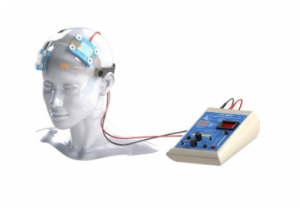อัมพาต กับการรักษาด้วย tDCS
ปัจจุบันมีเทคโนโลยีหลากหลายที่เป็นทางเลือกในการรักษาของผู้ป่วยโรคหลอดเลือดสมอง การรักษาด้วยการกระตุ้นไฟฟ้ากระแสตรงผ่านกะโหลกศีรษะ (Trans cranial direct current stimulation หรือ tDCS) เป็นเทคนิคการรักษาหนึ่งที่ไม่รุกรานทางสมองและไม่ก่อให้เกิดความเจ็บปวด โดยใช้เครื่องกระตุ้นไฟฟ้ากระแสตรงอย่างอ่อนลงไปยังสมองในส่วนที่บาดเจ็บ เพื่อให้สมองเกิดการฟื้นตัว ซึ่งเครื่อง tDCS เริ่มเข้ามามีบทบาทที่สำคัญต่อการช่วยเหลือคนไข้โรคหลอดเลือดสมอง อัลไซเมอร์ พาร์กินสัน ในการพัฒนาเรื่องการเดิน การพูดและความจำ
Transcranial Direct Current Stimulation (tDCS) มีองค์ประกอบของตัวเครื่อง 4 อย่าง ประกอบด้วย 1.ขั้วกระตุ้น (ขั้วบวกและขั้วลบ) 2.เครื่องกระตุ้นที่ติดกับขั้วเป็นตัวปล่อยกระแสไฟฟ้า 3.หมวกสวมศีรษะที่มีรู ซึ่งสัมพันธ์ระหว่างการวางขั้วกระตุ้นกับตำแหน่งที่อ้างอิงของสมองที่ต้องการรักษา 4.เครื่องควบคุมหลักในการตั้งค่า
กลไกการทำงานของ tDCS เป็นการกระตุ้นการปรับเปลี่ยนความต่างศักย์กระแสไฟฟ้าของเซลล์ประสาทในระยะพักของสมองให้กระแสประสาททำงานได้ดีและรวดเร็วกว่าเดิม โดยกลไกการทำงานของตัวเครื่องจะขึ้นอยู่กับตำแหน่งการรักษาและการวางขั้วกระตุ้นตามตำแหน่งของสมอง โดยมากผู้ให้การรักษาจะวางตำแหน่งของขั้วกระตุ้นที่มีความแตกต่างกัน ทำให้มีการนำ tDCS มาใช้ในทางระบบประสาทอย่างหลากหลาย ในทางปฏิบัติที่ผ่านมา จะวางขั้วกระตุ้นไว้ที่ตำแหน่งสมองที่ต้องการกระตุ้น เช่น ตำแหน่งมอเตอร์ (motor area) ตำแหน่งสมองส่วนหน้า (frontral area) และอีกขั้วจะเป็นขั้วอ้างอิง (reference electrode) ที่มักจะวางอยู่ที่ตำแหน่งเหนือกะโหลกเบ้าตาด้านตรงข้าม (contralateral supraorbitral area) แล้วจึงเริ่มตั้งต่าเครื่องกระตุ้นหลัก เปิดกระแสไฟฟ้าเข้าไปกระตุ้นสมองในส่วนที่บาดเจ็บหรือตำแหน่งที่ต้องการรักษาขนาด 0.5-2 มิลลิแอมแปร์ ใช้ระยะเวลาการรักษา 10–30 นาที เป็นเวลา 5-10 วัน ซึ่งวิธีนี้สามารถทำควบคู่กับการทำกายภาพบำบัดเป็นการเพิ่มประสิทธิภาพในการรักษาคนไข้โรคหลอดเลือดสมอง โรคสมองเสื่อม และโรคพาร์กินสัน ส่วนข้อห้ามของการรักษาด้วยเครื่อง tDCS คือ ไม่ทำในคนไข้ที่ใส่เครื่องกระตุ้นหัวใจ ไม่ทำในคนไข้ที่พึ่งบาดเจ็บทางสมอง ไม่ทำในคนไข้มะเร็ง ไม่ทำในคนไข้ตั้งครรภ์
tDCS จึงเป็นอีกทางเลือกหนึ่งในการรักษาคนไข้หลอดเลือดสมอง ซึ่งทำควบคู่ไปกับการทำกายภาพบำบัดเพื่อเป็นการเพิ่มประสิทธิภาพการรักษาในการกระตุ้นสมองส่วนที่ได้รับการบาดเจ็บ ให้มีการฟื้นตัวได้อย่างรวดเร็ว

อ้างอิง
– Nitsche MA, Cohen LG, Wassermann EM, Priori A, Lang N, Antal A, et al. Transcranial direct current stimulation: State of the art 2008. Brain Stimul. 2008; 1:206-23.
– Webster BR, Celnik PA, Cohen LG. Noninvasive brain stimulation in stroke rehabilitation. NeuroRx. 2006; 3:474-81.
– Lefaucheur JP, Antal A, Ayache SS, Benninger DH, Brunelin J, Filippo C, et al. Evidence-based guidelines on the therapeutic use of transcranial direct current stimulation (tDCS). Clin Neurophysiol. 2017; 56-92.
Paralysis with tDCS therapy
Nowadays, there are various technologies available as treatment options for stroke patients. Transcranial direct current stimulation (tDCS) is a non-invasive and painless treatment technique. by using a weak direct current electrical stimulator to the injured part of the brain for the brain to recover, where the tDCS began to play an important role in helping patients with stroke, Alzheimer’s, Parkinson’s in improving walking. speech and memory
Transcranial Direct Current Stimulation (tDCS) has four components:
1. Terminal stimulation (positive and negative poles)
2. The stimulator attached to the pole is an electric discharge.
3.Hat with holes which relates the placement of the stimulus electrode to the brain reference site to be treated.
4.Main controller to set up
The mechanism of action of tDCS is to stimulate the alteration of the electrical voltage of neurons in the resting phase of the brain so that the nerve impulse works better and faster. The working mechanism of the device depends on the treatment position and the placement of electrodes according to the position of the brain. Often, treatment providers place different stimulation electrodes, resulting in a wide variety of neurological applications for tDCS.
in practice in the past The stimulus electrodes are placed at the desired brain location, such as the motor area and the frontral area, and the other is the reference electrode, usually located above the opposite cranial orbit.
(contralateral supraorbitral area) and then the primary stimulus is set up. Use 0.5-2 milliamperes of electric current to stimulate the brain in the injured part or the area to be treated. The treatment period is 10-30 minutes for 5-10 days. Treatment of patients with cerebrovascular disease dementia and Parkinson’s disease The contraindications of tDCS therapy are not performed in patients with cardiac pacemakers. Not done in patients who have recently received traumatic brain injury. not done in cancer patients Not done in pregnant patients
tDCS is therefore an alternative treatment for cerebrovascular patients. This is done in conjunction with physical therapy to increase the healing efficiency of stimulating the injured brain. to have a quick recovery